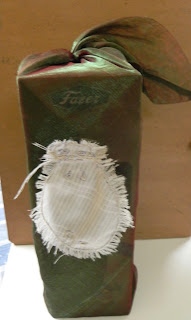How do you capture a fragrance so that every time the wind blows and the fragrance wafts towards you, your mind drifts back to the time when you first held, first walked, first watched, first felt, first realised..... ?
Dried lavender buds bought from a small shop in Marseille. Such heady perfume wafts out every time I open the packet. More than anything I saw or ate or felt, these buds acutely signify my journey and my solitude in those days.
I needed to find something pretty to do with them because that's what I feel when I look at them and hold them. Pretty and precious. Imagine the sun, even harsh sunlight, shining on young buds and fresh soft petals squeezing out the moisture - yet, it only manages to concentrate the perfume, which pervades the air wherever it is taken.
Here's a really short tutorial on making sachets to hold fragrant dried flowers.
All you need is some handmade paper, lace, gauzy fabric, and PVA glue. And of course the flower buds or petals of your choice.
Begin with the paper. Here I've used this slightly fibrous gold-embossed ivory paper. I have to tell you that I'm a big hoarder of pretty paper. I picked up one sheet of this paper about seven years ago for an exorbitant amount (then) of Rupees 80 for one sheet. And I still have some of it. I love the softness of it, almost like fabric. In fact, you could go with fabric as well if you prefer. Cut out two equal sized shapes from it. For some reason, maybe the colour of the buds, and the mood, I went with hearts. And from one of those shapes, cut out a smaller version of the same shape you chose. So you end up with two hearts, and a heart-shaped hole in one of them.
Then place the whole heart with the reverse side facing you. Use a length of pretty lace to make a loop and stick it on top.
Use your glue dispenser, to apply some glue along the edge. Use very little of it. Place a teaspoon or less of lavender buds on the middle of this heart shaped piece of paper.
Cut out a small bit of the gauzy fabric and place over the lavender buds. Make sure that this is large enough to cover the heart, but trim away any excess fabric. If you would like the lavender buds to stay in place, you could consider putting another line of glue just around the buds, so that the gauze sticks closer to the buds and holds them in place.
Next, quickly, take the other heart shape (with the heart-shaped hole) and position it so the hole fits over the lavender buds. Apply more glue lightly if necessary, pressing gently so that all the edges are sealed.
Voila, your little lavender sachet is ready!
I felt the greatest happiness when I saw how pretty it turned out, and how easy it was! I can't wait to try it with other flower petals.














































